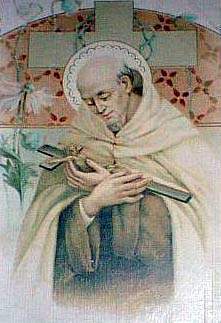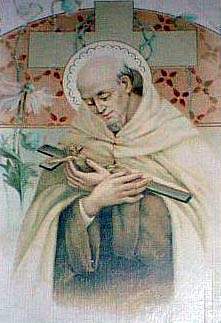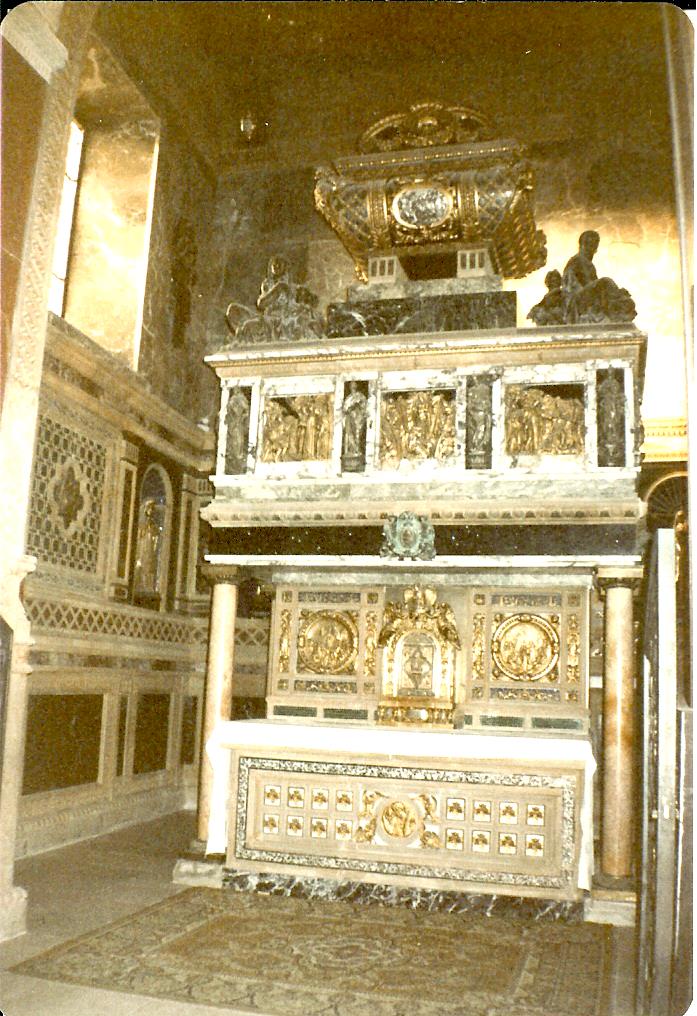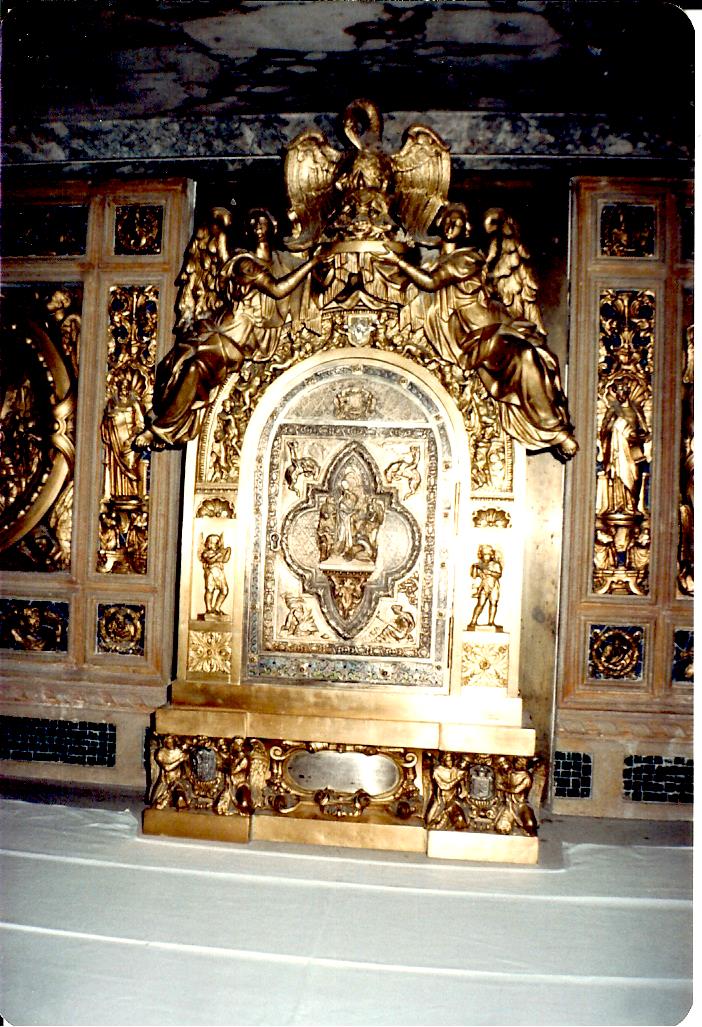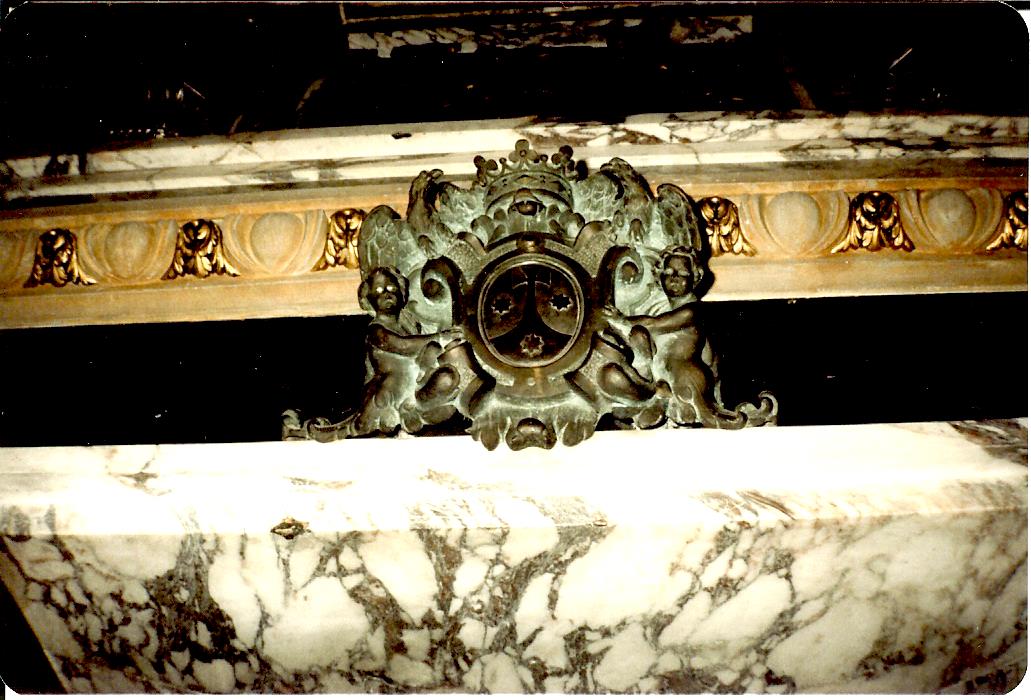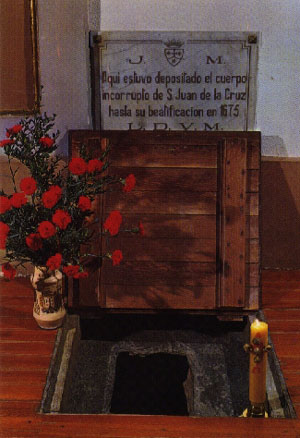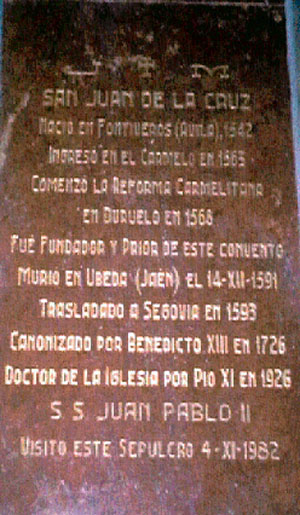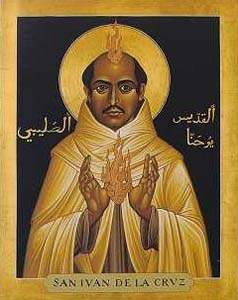Born Juan de Yepes y Alvarez into a Jewish converso (converted to Catholicism) family in Fontiveros, Spain, his father worked as an accountant to richer relatives who were silk merchants prior to marrying his mother, who was an orphan from a lower class of people. When his father married, he was rejected by his family and forced to work as a weaver along with his mother. When his father died in 1545, his mother moved the surviving family, first to Arevalo, Spain, in 1548, and then to Medina del Campo in 1551 where she found employment as a weaver.
There, he received a basic education, mainly in Christian doctrine, along with food, clothing, and lodging. While attending school, he became an acolyte at a nearby Augustinian nuns' monastery. He later worked at a hospital and studied humanities at a Jesuit school from 1559 to 1563.
In 1563, he entered the Calced Carmelite Order and took the name John of Saint Matthias. A year later, he professed his religious vows as a Carmelite and travelled to Salamanca, Spain, where he studied theology and philosophy at the University. In 1567, he was ordained as a priest with the intention of joining the strict Carthusian Order, known for its solitary and silent contemplation. Returning to his home in Medina shortly after his ordination, he met Teresa of Jesus (Teresa of Avila), a charismatic Carmelite nun, who traveled there to start a convent for women, and who was wanting to restart the observance of Carmelite Order's "Primitive Rule" of 1209, which had been relaxed by Pope Eugene IV in 1542. She persuaded him to delay his becoming a Carthusian and join her quest, which he did.
They traveled around Spain for the next few years, establishing monasteries for nuns and friars, before settling in Avila, Spain, where he became the spiritual director and confessor for Teresa at the Monastery of Visitation and remained there until 1577.
From 1576 to 1577, tensions increased among the Spanish Carmelite friars over their reforms. John was arrested in January 1576, but was soon released. In December 1577, he was arrested again and taken to the Carmelite monastery in Toledo, Spain, where he was tried for disobedience and found guilty. He was jailed at the monastery in a tiny, stifling cell measuring ten feet by six feet, where he was subjected to harsh treatment, including weekly public lashings and a meager diet of water, bread, and scraps of salted fish. During his imprisonment, he wrote a majority of his most famous poem "Spiritual Canticle," as well as other shorter poems on paper that was secretly provided to him by the friar who guarded his cell.
On August 15, 1578, he managed to escape through a small window in a room that adjoined his cell. After his health was restored, he met with other supporters of the reform (known as the Discalced Carmelites) in October 1578 at Almodovar del Campo where they decided to demand from the Pope their formal separation from the rest of the Carmelite Order. He was appointed the Superior of the El Calvario monastery where he composed his first version of his commentary on his poem, "Spiritual Canticle."
In 1579, he moved to Baeza, Spain, to serve as Rector of the newly founded college, Colegio de San Basilio and remained there until 1582. On June 22, 1580, Pope Gregory XIII signed a decree, "Pia Consideratione," that finally authorized a separation between the Calced and Discalced Carmelites. ("Calced" means "shod," that is "wearing shoes." "Discalced" means "unshod" or "barefoot.") The Discalced Carmelites go barefood or wear sandals.
On March 3, 1581, at the first General Chapter of the Discalced Carmelites in Alcala de Henares, Spain, he was elected one of the "Definitors" and wrote a set of constitutions for them. In May 1585, he was elected the Provincial Vicar of the Discalced Carmelites in Andalusia. During this time, he continued to travel throughout Andalusia, establishing new monasteries and making annual visitations. In June 1588, he was elected Third Councillor to the Vicar General for the Discalced Carmelites, Father Nicolas Doria, and relocated to Segovia in Castile, Spain.
In June 1591, after a disagreement with Father Doria over restructuring of the leadership of the Discalced Carmelite Order, he was removed from his post and sent to an isolated monastery in Andalusia called La Penuela, where he became ill. He travelled to the monastery at Ubeda, Spain, for treatment, but his condition worsened, and he died there of erysipelas, an acute streptococcus bacterial infection of the upper dermis and superficial lymphatics.
He was originally interred at Ubeda, but, at the request of the monastery in Segovia, his body was secretly reinterred there in 1593. When the citizens of Ubeda learned that his remains had been moved, they petitioned Pope Clement VIII for the remains to be returned, which was granted in October 1596. Through a compromise, the superiors of the Discalced Carmelites decided the monastery at Ubeda would receive one leg and one arm of the remains (they had already kept one leg in 1593), and the head and torso would remain at the monastery at Segovia.
John of the Cross was beatified in 1675 by Pope Clement X and canonized as a saint by Pope Benedict XIII in 1726. In 1926, he was declared a Doctor of the Church by Pope Pius XI. His writings were first published in 1618, and the "Spiritual Canticle" was first included in the 1630 edition. His other renowned poetic works include "The Dark Night of the Soul," "The Ascent of Mount Carmel," "Living Flame of Love," and "Sayings of Light and Love."
Born Juan de Yepes y Alvarez into a Jewish converso (converted to Catholicism) family in Fontiveros, Spain, his father worked as an accountant to richer relatives who were silk merchants prior to marrying his mother, who was an orphan from a lower class of people. When his father married, he was rejected by his family and forced to work as a weaver along with his mother. When his father died in 1545, his mother moved the surviving family, first to Arevalo, Spain, in 1548, and then to Medina del Campo in 1551 where she found employment as a weaver.
There, he received a basic education, mainly in Christian doctrine, along with food, clothing, and lodging. While attending school, he became an acolyte at a nearby Augustinian nuns' monastery. He later worked at a hospital and studied humanities at a Jesuit school from 1559 to 1563.
In 1563, he entered the Calced Carmelite Order and took the name John of Saint Matthias. A year later, he professed his religious vows as a Carmelite and travelled to Salamanca, Spain, where he studied theology and philosophy at the University. In 1567, he was ordained as a priest with the intention of joining the strict Carthusian Order, known for its solitary and silent contemplation. Returning to his home in Medina shortly after his ordination, he met Teresa of Jesus (Teresa of Avila), a charismatic Carmelite nun, who traveled there to start a convent for women, and who was wanting to restart the observance of Carmelite Order's "Primitive Rule" of 1209, which had been relaxed by Pope Eugene IV in 1542. She persuaded him to delay his becoming a Carthusian and join her quest, which he did.
They traveled around Spain for the next few years, establishing monasteries for nuns and friars, before settling in Avila, Spain, where he became the spiritual director and confessor for Teresa at the Monastery of Visitation and remained there until 1577.
From 1576 to 1577, tensions increased among the Spanish Carmelite friars over their reforms. John was arrested in January 1576, but was soon released. In December 1577, he was arrested again and taken to the Carmelite monastery in Toledo, Spain, where he was tried for disobedience and found guilty. He was jailed at the monastery in a tiny, stifling cell measuring ten feet by six feet, where he was subjected to harsh treatment, including weekly public lashings and a meager diet of water, bread, and scraps of salted fish. During his imprisonment, he wrote a majority of his most famous poem "Spiritual Canticle," as well as other shorter poems on paper that was secretly provided to him by the friar who guarded his cell.
On August 15, 1578, he managed to escape through a small window in a room that adjoined his cell. After his health was restored, he met with other supporters of the reform (known as the Discalced Carmelites) in October 1578 at Almodovar del Campo where they decided to demand from the Pope their formal separation from the rest of the Carmelite Order. He was appointed the Superior of the El Calvario monastery where he composed his first version of his commentary on his poem, "Spiritual Canticle."
In 1579, he moved to Baeza, Spain, to serve as Rector of the newly founded college, Colegio de San Basilio and remained there until 1582. On June 22, 1580, Pope Gregory XIII signed a decree, "Pia Consideratione," that finally authorized a separation between the Calced and Discalced Carmelites. ("Calced" means "shod," that is "wearing shoes." "Discalced" means "unshod" or "barefoot.") The Discalced Carmelites go barefood or wear sandals.
On March 3, 1581, at the first General Chapter of the Discalced Carmelites in Alcala de Henares, Spain, he was elected one of the "Definitors" and wrote a set of constitutions for them. In May 1585, he was elected the Provincial Vicar of the Discalced Carmelites in Andalusia. During this time, he continued to travel throughout Andalusia, establishing new monasteries and making annual visitations. In June 1588, he was elected Third Councillor to the Vicar General for the Discalced Carmelites, Father Nicolas Doria, and relocated to Segovia in Castile, Spain.
In June 1591, after a disagreement with Father Doria over restructuring of the leadership of the Discalced Carmelite Order, he was removed from his post and sent to an isolated monastery in Andalusia called La Penuela, where he became ill. He travelled to the monastery at Ubeda, Spain, for treatment, but his condition worsened, and he died there of erysipelas, an acute streptococcus bacterial infection of the upper dermis and superficial lymphatics.
He was originally interred at Ubeda, but, at the request of the monastery in Segovia, his body was secretly reinterred there in 1593. When the citizens of Ubeda learned that his remains had been moved, they petitioned Pope Clement VIII for the remains to be returned, which was granted in October 1596. Through a compromise, the superiors of the Discalced Carmelites decided the monastery at Ubeda would receive one leg and one arm of the remains (they had already kept one leg in 1593), and the head and torso would remain at the monastery at Segovia.
John of the Cross was beatified in 1675 by Pope Clement X and canonized as a saint by Pope Benedict XIII in 1726. In 1926, he was declared a Doctor of the Church by Pope Pius XI. His writings were first published in 1618, and the "Spiritual Canticle" was first included in the 1630 edition. His other renowned poetic works include "The Dark Night of the Soul," "The Ascent of Mount Carmel," "Living Flame of Love," and "Sayings of Light and Love."
Bio by: William Bjornstad
Advertisement
See more de la Cruz memorials in:
Explore more
Sponsored by Ancestry
Advertisement
